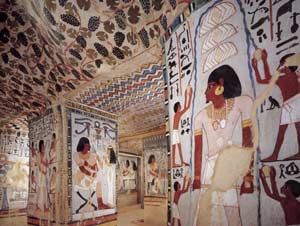
Example:

"The group was not finished, since the lower part has not been fully smoothed. Paint was applied, as seen in the traces of red on the king's ears, and sheet gold may once have covered the woman's wig and the king's headdress. The coverings would have incorporated a cobra above the king's forehead and, possibly, a vulture headdress above the queen's wig. For the first time in Egyptian art, both royal heads are not images of idealized royalty but portraits of specific holders of the offices. The king's bulbous eyes, hanging flesh on the cheeks, and drooping lower lip are unmistakably features of an individual, as are the queen's long full neck and small mouth. While the king's body is ideally youthful and athletic, one might see hints of maturity in the woman's breasts." - metmuseum
Like I stated elsewhere, each timeframe had its own peculiarities in art. For instance, as the above example shows, attempts to capture unique expressions of the real subject were made, which clearly distinguishes him from other subjects, while the body muscle and youthfulness *might* be a little exaggerated. This was the trend in the old kingdom.
Of course, other sculptures maybe wholly idealistic, further highlighting the need to examine each art carefully on case by case basis. For instance, this bust of Khafre:

"Head of King Khafre. Giza; Fourth Dynasty, reign of Khafre (ca. 2520–2494 B.C.E.).
This face is broader than most representations of Khafre and the features are idealized and distant. Alabaster, often slightly translucent, sometimes with warm tones, was popular during the reigns of Khafre and Menkaure." - metmuseum
Contrast this with:

King Khafre Seated. Giza; Fourth Dynasty, reign of Khafre (ca. 2520–2494 B.C.E.). - metmuseum
...Which is more lifelike, and in tune with many of the other available portraiture of this ruler.
Similarly this Tutankhamun, it appears that attempts were made to capture his individual traits, including the color.

The following limestone sculpture clearly indicates a relatively older Akhenaten and Nefertiti

Various sculptures are idealized, but not every one is.
[This message has been edited by Super car (edited 18 March 2005).]
Color only becomes symbolic when you have a ka,khat,or ba statue. In some cases the reddish-brown for males and yellowish color for female is symoblic. When we get into the eighteenth dyansty people begin to be depicted with more realism.
quote:??
Originally posted by Doug M:
What he means is that it is OK to ignore brown skin
coloring in order to JUSTIFY making them look like WHITE people in modern reconstructions and paintings.
quote:you know
Originally posted by Supercar:
quote:??
Originally posted by Doug M:
What he means is that it is OK to ignore brown skin
coloring in order to JUSTIFY making them look like WHITE people in modern reconstructions and paintings.
![[Wink]](wink.gif)



quote:Never suggested it was a new topic; hint: take a peek at when this thread was first created!
Originally posted by Djehuti:
Sorry supe, but this topic has been discussed several times before.
quote:Rahotep, in color scheme alone, isn't unique. The authenticity of the sculpture lies elsewhere in details, i.e., general codes of artistic expression of royalty or ruling elite figures, as opposed to what the figure merely looks like.
Djehuti:
This whole nonsense about "symbolism" is only used by folks who are in DENIAL.
quote:Why am I not surprised that Hore would use Rahotep again!
Originally posted by Horemheb:
Art history people classify most egyptian art as symbolic. Some of it is naturalistic (i.e. Rahotep) but most is not.

![[Big Grin]](biggrin.gif)








![[Wink]](wink.gif)


![[Big Grin]](biggrin.gif)
quote:Strange that the only ones that show Tiye with a smile are the monumental statues, but then again such statues also do not show the personal features attributed to Tiye:
Originally posted by Supercar:
Those portraits of Tiye, are interesting though, in that none of them exhibit a smile on the face.









quote:We know darker-skinned populations existed/still exists among the people groups labeled 'Indan' and 'Arab', but especially back then.
Wally, when considering the histories of both peoples, do you think the Hindu and Arab artistic ideal of 'white' was a later influece??..


quote:Hey DJ
Originally posted by Djehuti:
^^Wally I already know what you are talking about but my question stands...
quote:We know darker-skinned populations existed/still exists among the people groups labeled 'Indan' and 'Arab', but especially back then.
Wally, when considering the histories of both peoples, do you think the Hindu and Arab artistic ideal of 'white' was a later influece??..
Although there were no painted images left behind by Arabs and Indians in ancient times like in Harapa, it can be inferred that these peoples no where near resembled the light/bright images we see today.
With all of this said, don't you find it plausible that the more recent idealistic depictions in art come from later influence?
Btw, While it's true that the Chinese often depicted themselves as very light they also depicted neighboring East Asians like the Mongols and even southern Chinese in darker tones.